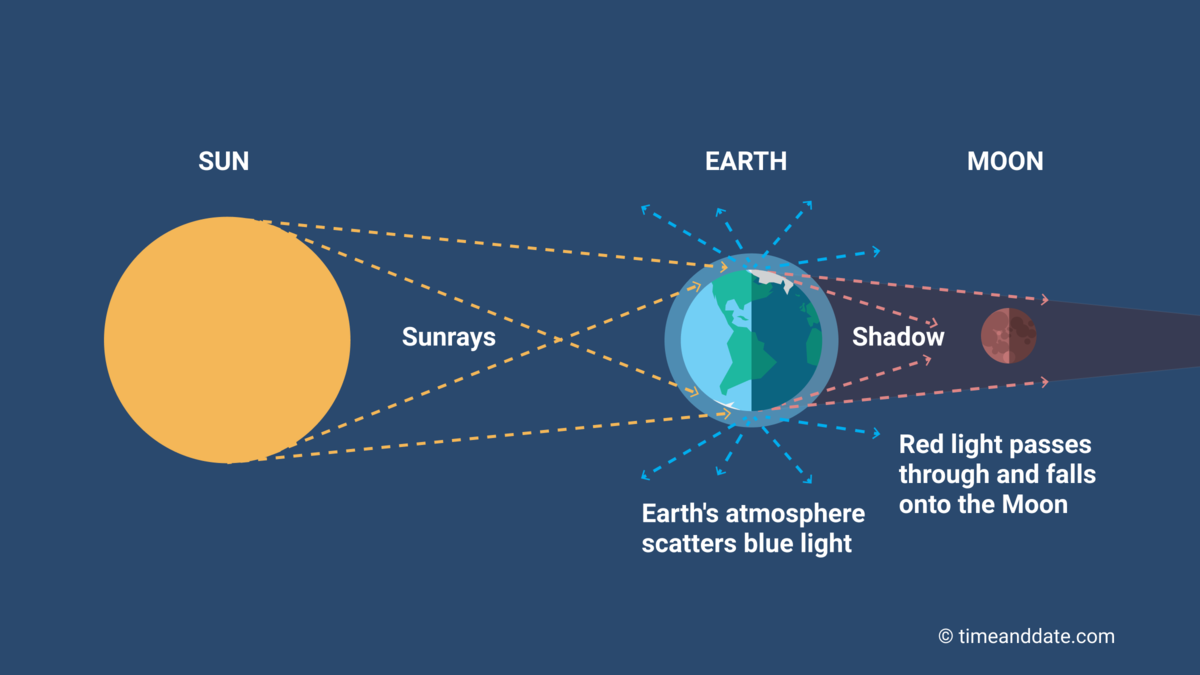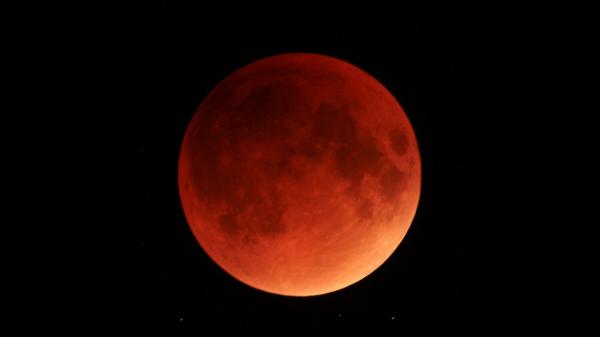What Is a Blood Moon?
A total lunar eclipse is sometimes called a Blood Moon, because of the reddish tinge the Full Moon takes on when fully eclipsed. The term is also frequently used to describe four total lunar eclipses that occur in a row.

Next Total Lunar Eclipse: 2025年3月14日金曜日 … See animation


Earth's atmosphere filters out blue light.
Why Are Blood Moons Red?
Blood Moon is not a scientific term, though in recent times it is being widely used to refer to a total lunar eclipse because a fully eclipsed Moon often takes on a reddish color—like in the image below, which was taken during the total lunar eclipse in September 2015.
Eclipses in your city (with animations)
So, why does the Moon turn red?
A total lunar eclipse happens when the Moon travels through the Earth's umbra and blocks all direct sunlight from illuminating the Moon's surface. However, some sunlight still reaches the lunar surface indirectly, via the Earth's atmosphere, bathing the Moon in a reddish, yellow, or orange glow.
As the Sun's rays pass through the atmosphere, some colors in the light spectrum—those towards the violet spectrum—are filtered out by a phenomenon called Rayleigh scattering. This is the same mechanism that causes colorful sunrises and sunsets. Red wavelengths are least affected by this effect, so the light reaching the Moon's surface has a reddish hue, causing the fully eclipsed Moon to take on a red color.
Sunrise and sunset times in your city
Depending on the composition of the atmosphere, different parts of the light spectrum are filtered out, so the Moon may also look yellow, orange, or brown during a total lunar eclipse.

Blood Moon in September 2015.
Deanne Fortnam
Lunar Tetrad
The term Blood Moon is also sometimes used to refer to four total lunar eclipses that happen in the span of two years, a phenomenon astronomers call a lunar tetrad. The eclipses in a tetrad occur about six months apart with five uneclipsed Full Moons between them.
Usually, only about one in three lunar eclipses are total, and about four to five total eclipses can be seen from any single location on Earth in a decade. This means that lunar tetrads are rare occurrences, leading some to attach special, even religious, significance to these events.
The 2014–2015 lunar tetrad gathered a lot of attention because of claims by some religious organizations that the eclipses in the tetrad were a sign of the end times. Some even called the eclipses Blood Moons after a statement in the Book of Joel in the Hebrew Bible, that referred to the Sun turning dark and the Moon turning red before the second coming of Jesus.
Other doomsday prophecies that fell short
How Often Do Lunar Tetrads Happen?
It depends on the century you look at. Italian astronomer Giovanni Schiaparelli calculated that the occurrence of lunar tetrads varies over centuries. Some have several lunar tetrads, while others do not have any. For example, the years between 1582 and 1908 did not have any tetrads, whereas the next 250 years—from 1909 to 2156—will have 17 tetrads.
The current century—2001 to 2100—will have eight tetrads. The first tetrad of the 21st century took place in 2003-2004, the second was in 2014–2015, and the next will be in 2032–2033, with the following eclipses:
Hunter's Moon
The Full Moon in the month of October is also sometimes called a Blood Moon in many North American cultures. This name comes from the fact that October is usually when hunters spend time hunting game and preparing meat for the coming winter. The October Full Moon is also known as Hunter's Moon or Harvest Moon.




